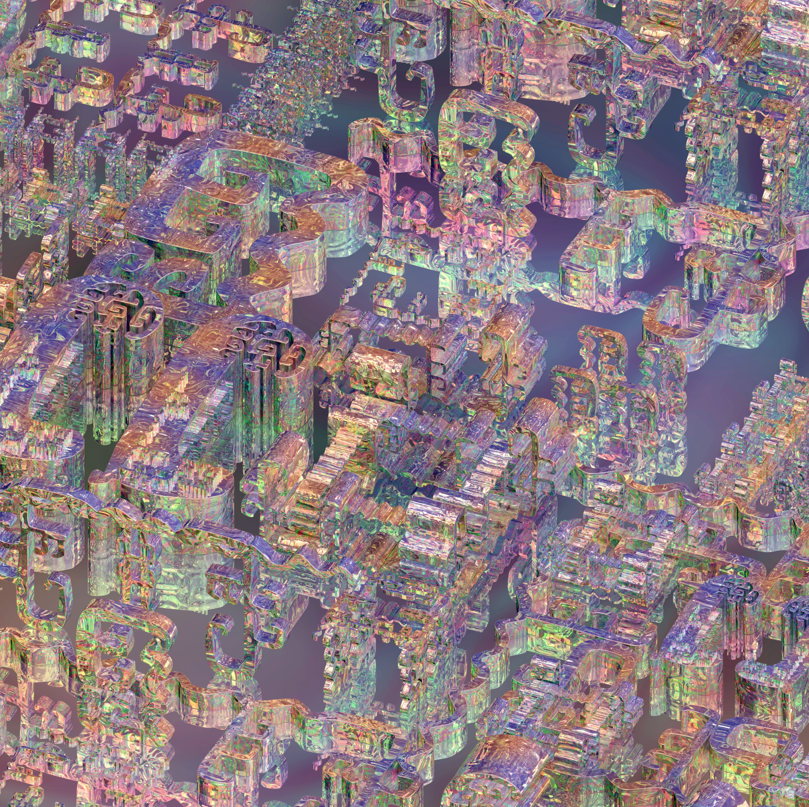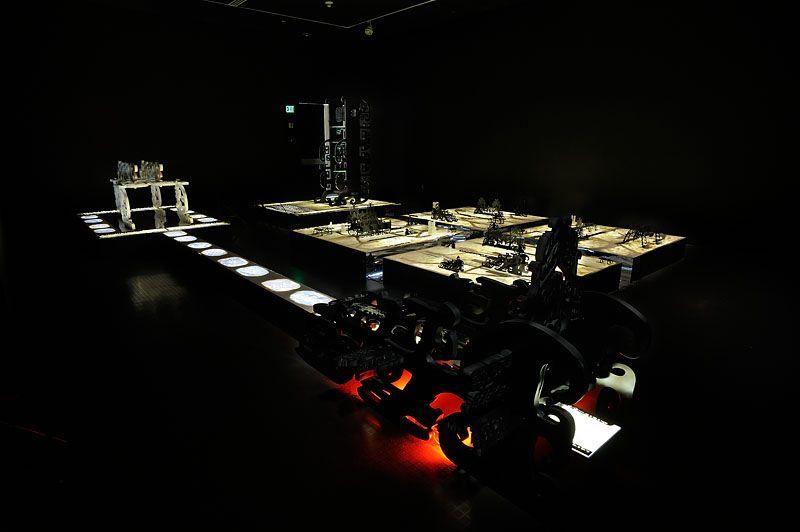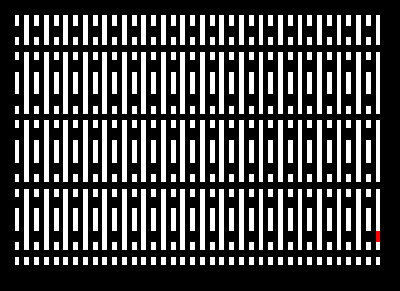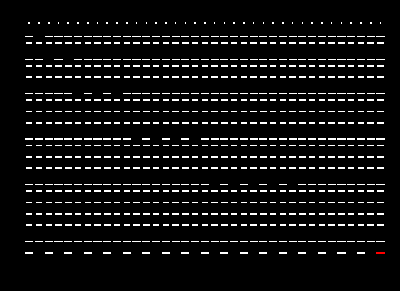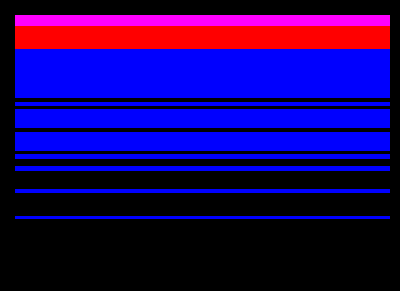![]()
Gridfont by A Bill Miller Image and interlaced Helvetica font by Rosa Menkman
Last March the (ᴳ̐litch) Art Genealogies exhibition took place at
LEAP Gallery in Berlin. The exhibition statement said; "[...] The exhibition focuses on the different threads that interconnect generations of the different communities of visual (glitch) artists and their working methods, conceptual themes and problematics.
(glitch) Genealogies fragments Glitch history into multiple (historical) categories, such as ’NES-Aesthetics’, ‘Enigmatic realities’, ‘GUI, Politics and Prose’, ‘psychedelia and the new psychedelia’ and ‘discontinuous systematicities’"
Rosa Menkman, who curated the show together with Daniel Franke and John McKiernan went deeper, analyzing and writing about (Glitch) Art Genealogies. She launched the essay yesterday as a downloadable file In this post you can see some fragments from the different categories and some references from artists who are part of the essay. See more;NOTE All the information and references below are courtesy Rosa Menkman from (Glitch) Art Genealogies essay. The complete essay can be downloaded here. (Glitch) Art Genealogies essay by Rosa Menkman
«Over the last 10 years, glitch, a perceived break from a flow in a technological system, has become a more and more popular subject matter in the (new) media arts. Today, Glitch Art is indeed so popular that theorists often feel the need to categorize and historicize the genre. Dada, Futurism and de Stijl are just a couple of historical Avant-Garde movements that have been used to delineate ‘the history’ of Glitch Art. But this teleological principle defies and confines glitch’ procedural and fragmented nature.
The exhibition (ᴳ̐litch) Art Genealogies does not focus on glitch art from a historically singular point of view, nor does it attempt to give an all encompassing historical or causal overview. Instead, (ᴳ̐litch) Art Genealogies recognizes the complexities and processes of glitch arts’ many affiliated, interconnected and (geo-)fragmented discourses: it tries to shine a light on why particular glitches develop social-political momentum in a specific point in time and how this momentum changes over time.
(ᴳ̐litch) Art Genealogies is an effort to show just five of the many threaded glitch discourses that play a role in the curators subjective understanding of glitch art at this present. In these threads, generations of different communities of (visual) glitch artists and their working methods, conceptual themes and politics are (inter)connected and/or juxtaposed.»
[...]Psychedelia and New Psychedelia
[...] Psychedelic arts’ original aesthetics such as hallucinatory patterns, recursion, fractals and bright colors are illustrative to glitch, not necessarily because glitch artists have similar convictions or esthetic vision as 1960s psychedelic artists, but rather because of glitch arts’ algorithmic nature which was often referenced in 1960s psychedelic art. However, some glitch works seem to draw direct lines of inspiration or even knowledge (in the case of Anton Marini through collaboration) from these early times of counterculture. What does it mean to re-fabricate a genre 50 years after its coming about? And what is this ‘new’ in new psychedelia?
gridSol_altar2 by A Bill Miller
Sect 7 N-E, 2013 by Anton Marini vs Rutt Etra
AURAE, 2012 by Sabrina Ratte
GUI Politics and Prose
The collection Graphic User Interface (GUI) Politics and Prose shows glitch works that expand and explore the meaning and materiality of the GUI. Traditionally, the GUI functions to enhance the efficiency and ease of use of a computer program - in short: to enlarge 'usability'. But in these videos the GUI is exploited to enact a battle at the boarders of system and entropy, standardization and corruption, expression and code, and meaning and non-meaning, thwarting the viewers’ expectations and conventions of the ‘usability’ of a GUI.
JODIs early work My%Desktop (2002-2010) for instance, is best understood as a rejection of what can be referred to as GUI based ‘determinism’. At first sight, this series shows a collection of OS_systems going haywire, ruined and void of meaning. But the GUIs formal fragmentation or what seems to be a remarkably well choreographed spasming, forces the spectator to consider the work more closely. It seems like there is actually something more than just GUI-chaos on display. After reflecting upon the work for a while, it becomes clear that JODI is actually performing the GUI. The conventions I am conditioned to approach a GUI with, are left behind and instead the GUI has been deconstructed into a performance tool and maybe even something close to a writerly software.
[...]
OS Desktop from the My%Desktop series, 2002-2010 by JODI
Plugin Beachball Success, 2012 by Jon Satrom
Post_it_desktop_Feedback, 2012 MiYö Van Stenis
NES circuitbending esthetic
Circuitbending is the customization of the circuits within electronic devices such as children's toys, to create new musical or visual instruments generating output beyond their original capabilities. It involves a certain threshold of knowledge and expertise - ie. a basic understanding of electronics and its tools.
[...]
The concept that a glitch can be designed or distributed through a standardized glitch software, seems at first maybe a-typical, but has in fact become a more and more common tendency and even important tradition in recent glitch art. More and more ‘new’ glitch art is being modeled after original glitches within older media, perpetuating a shift from destabilizing breaks within technology or information-based processes towards the generic and associative display of more and less ‘retro’ effects.
[...]
The Punch-Out! Variations, 2007 by noteNdo
glitchNES, 2009 by no_carrier
![]()
Enigmatic Realities
A video card barfs misunderstood RAM, all clipping modes are off, navigation causes environments to warp into all kinds of impossible angles while traces of passed imagery seem to get stuck in the sky and color modes have chosen to celebrate the 60s psychedelia once again. In these six game engine based ‘realities’, the rules of the frameworks that the player normally uses to make sense and navigate their videogames with, are intentionally ruined.
[...]
The fact that the game environments still ‘function’, while programmed to ‘glitch’, makes them critically challenging. The gaming platform is in fact redefined to not follow its genre, form or technique and force the user to reflect upon her conventional frames of reference for the particular platform. Finally it becomes clear that software is more than just a preprogrammed tool: it is a materialization of social modalities, that can endlessly be re-modified into different interpretive or social conclusions.
[...]
RANDOM SEED, 2013 by Rick Silva
Psych and Seek 2013 by Kevin Carey
Authorship // Openness
Primarily active during the 70s as both activist and video artist based in and around Chicago, Phil Morton (1945 - 2003) wrote "Distribution Religion", a manifesto based on a conviction best understood as what today is known as ‘copy it left’ (but which Morton dubbed COPY RIGHT). Distribution Religion included the first DIT ‘open sourced’ schematics for an image processor, made by Dan Sandin. Mortons legacy also includes the film and video department of the the School of the Arts Institute Chicago, which Morton instigated and which is believed to be one of the earliest institutionalized film and video departments in the world.
Mortons convictions still resonate in current video art practices of (SAIC/Chicago based) artists such as jonCates, who initiated the Phil Morton Memorial Research Archive in 2007, and Nick Briz whose Apple Computers (2013) is a [re]mix of Phil Morton's 1976 video tape 'General Motors'. In these (dirty) new media manifestos, Briz and Cates perform their take on issues of ‘Hystories’, planned obsolescence, upgrade culture, technological self-reliance, control and copying.
General Motors, 1970 by Phil morton
!"⟲#3! ⟒Ɍ3"""⟳Ɽ̂ ồ (AKA: Broken Records: Hystories i Of Noise && Dirty New Media), 2011 by jonCates
Apple Computers, 2013 byNick Briz
Rosa Menkman, July 2013
The exhibition and essay include works by :
Kim Asendorf,
Nick Briz,
jonCates,
Kevin Carey,
Anton Marini filter inspired by
Bill Etra,
Emilio Gomariz,
Jodi,
Nick Kegeyan,
Alex Myers,
Phil Morton,
A Bill Miller,
Brenna Murphy,
no_carrier,
noteNdo,
Julian Oliver,
Bryan Peterson,
Sabrina Ratté,
jon.satrom,
Rick Silva,
Yoshi Sodeoka and
miYö Van Stenis.
Arte made a nice short documentary about check it out
here, in german though.
![]()





















+Art+Genealogies.jpg)
+Art+Genealogies+2.png)




















































































